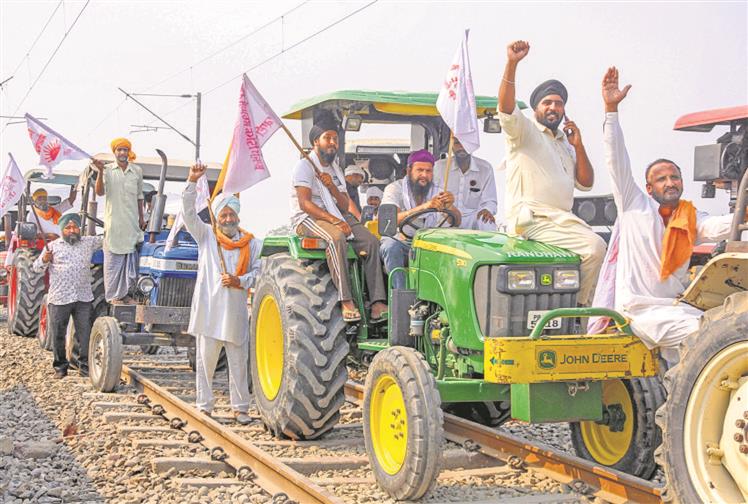
BLOCKADE: Stopping trains is a preferred action during any agitation in India.
M Rajivlochan
Historian
The farmers’ agitation in Punjab has shown us the limits of roko andolans in contemporary India. They inevitably peter out unless they are for a just cause. This would be the second major roko andolan to happen in the past year. The previous one was the Shaheen Bagh protest in Delhi, where mostly Muslim women blocked an entire market street against the Citizenship (Amendment) Act of 2019. The anti-CAA protest fizzled out after a hundred days.
It was Gandhi who perfected andolan techniques during the non-cooperation movement in 1920-22. The andolan has to be for satya — truth — Gandhi would say. Erik Erikson, the psychiatrist who studied Gandhi’s techniques of non-violent protest, pointed out that before launching an agitation, Gandhi made efforts to build bridges with his opponents. His success came from the fact that he put in great effort to formulate a non-negotiable demand which was also just. It was just not from the point of view of the protestors, but also that of those against whom the protest was being carried out.
However, not everyone has the stamina, wisdom or ability to reach out to opponents as Gandhi had. The leaders of farmers today certainly don’t have it.
Farmers in Punjab came out on the streets on the September 25, to protest against the farm laws that the Modi government had brought in. In Punjab, which prides itself on being a farming state, the cause was emotive enough for a large number of people to come forward to support the farmers. Patwaris, traders, unions of various state government employees, commission agents, dairy farmers, singers, artistes and all major political parties came out in support. Even many from the BJP announced their support. How far this support was because people genuinely believed in the cause is anyone’s guess.
The farmers’ leadership, coming from some 31 different politically active groupings, insisted that unless the laws were withdrawn, the farmers would stop work across the state — and also force other people to stop work. This has been a fairly common way of protesting in India. Usually, it meets with a fair amount of social approval, if not indifference, leaves the participants quite elated, irrespective of whether it achieves its goals or not. But then, achieving a goal is seldom the objective of such a protest. Showing annoyance is.
In the present instance, the first step in this protest was to stop all movement on major roads. With more than 50,000 trucks entering Punjab every day just from the Shambhu barrier, the stoppage of roads was bound to have a serious impact. It did. Not on the economy or the government or the political parties, but on the truckers manning these vehicles. Their trucks were stranded. Within a few days, reports came in that the truckers had started an agitation of their own. They wanted the roads to be opened so that they could go back home. That was the first major setback for the farmers’ agitation. They had to open the roads.
The farmers did ensure that all movement became toll-free. This, however, would have hurt only the concessionaire and none else. The concessionaires were not bothered about losing revenue in this way since their contracts state that they can collect revenues till such time that they recover the cost of the roads, plus a little more. If stopping toll collection pleased the farmers, made them imagine that they were empowered, then the concessionaire wasn’t going to disabuse them of such fancies. The losses could always be recouped at a later date from the same farmers.
The farm agitation then shifted to the railway tracks. Stopping the movement of trains is a preferred action in any agitation in India. Once in a while, trains are also burnt to demonstrate the intensity of the agitation. One such burnt train has been standing on the sidings in Jalandhar since 2009, when the locals had decided to express their annoyance at a happening in far off Vienna.
The agitating farmers in 2020 hadn’t burnt any train. But their insistence on stopping all trains did cause hurt all around. Some trains had been stopped since September 24. Meanwhile, the initiative of the Punjab Assembly to pass laws that tried to rescind the impact of the laws that the Parliament had passed did not seem to appease the farmers, though they welcomed the Assembly’s initiative. The blockade of trains was extended to all tracks on October 1.
No one complained about it for a few days. The military, which was stocking up materiel in the Himalayas to challenge the Chinese incursion in Leh-Ladakh, quietly shifted to transporting its goods by trucks, though movement by truck is almost twice as costly as that by railroad. By the third week of the rail roko stir, however, some people had started complaining about shortages.
Farmers, those who were cultivating their lands, complained about the shortage of fertilisers and other agricultural inputs that would have come by train. Industrialists complained about their inability to meet with export commitments since trains had been stopped. Manufacturers rued the absence of material to manufacture.
None of this evoked a positive response from the farmers till the thermal power plants in Punjab reported that they had exhausted their coal reserves and, in the absence of fresh supplies, were planning to shut down the generation of electricity. The fear of power outages seemed to have had an impact. Which is surprising, considering that till just a few years ago, everyone in Punjab was living with long power outages. But this time, the issue of electricity shortage seemed to be emotive enough.
On October 21, the leaders of agitating farmers announced that they would allow the movement of goods trains. Now, it was the turn of the railway management to baulk and insist that it would run trains only if all tracks were vacated and the movement of all trains allowed.
As of today, the farmers remain insistent that they would suffer if the farm laws are implemented. Whether the public believes this is yet to be seen.
Join Whatsapp Channel of The Tribune for latest updates.




























